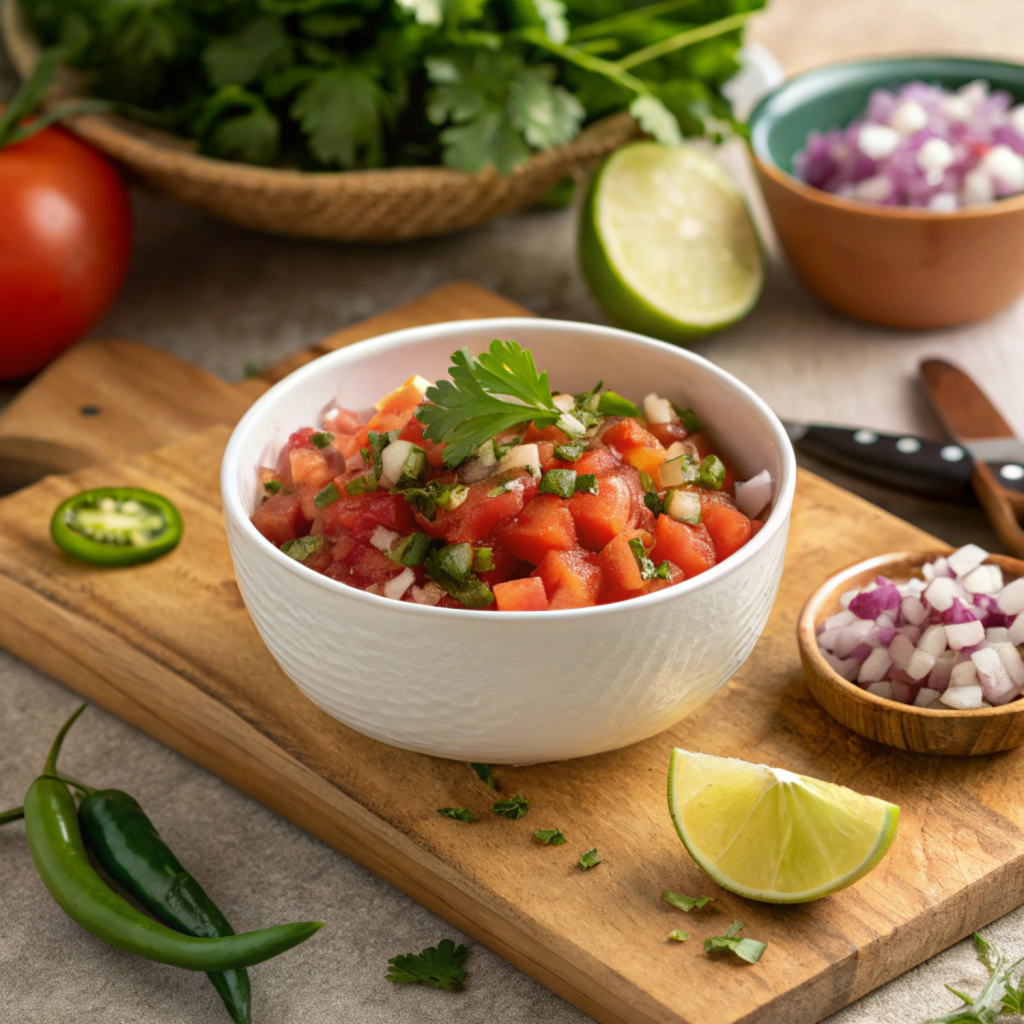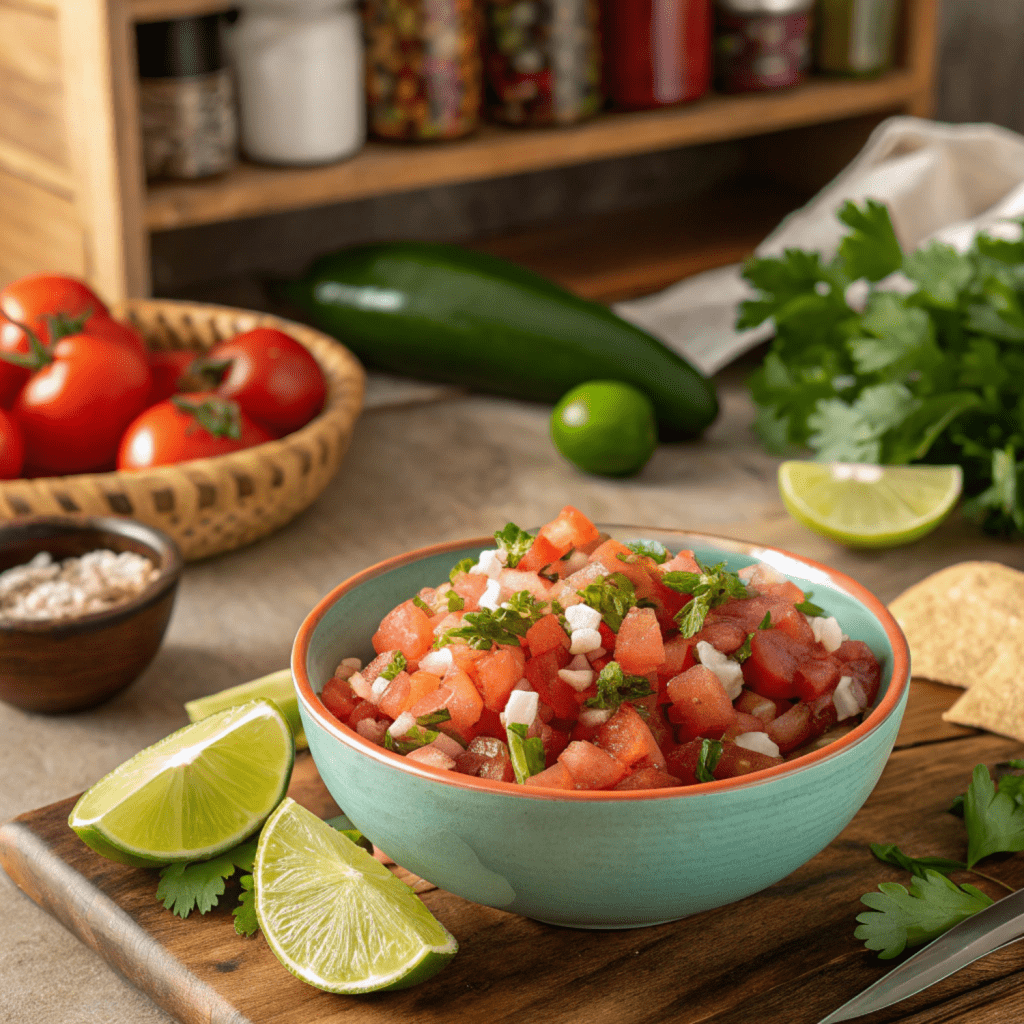
Homemade salsa with fresh tomatoes bursts with vibrant flavors and brings a taste of summer to any table. This zesty condiment, rooted in rich culinary traditions, transforms simple ingredients into a versatile dip, topping, or side. Whether you’re hosting a party or craving a fresh snack, making salsa at home is easy, healthy, and endlessly customizable. In this guide, we’ll explore how to craft the perfect homemade salsa with fresh tomatoes, trace its origins, highlight its nutritional benefits, and share tips to elevate your recipe.
The Origins of Homemade Salsa with Fresh Tomatoes
Salsa, meaning “sauce” in Spanish, traces its roots to Mesoamerica. The Aztecs, Mayans, and other indigenous peoples of Mexico blended tomatoes, chilies, and herbs as early as 3000 BCE. These early salsas, often called salsa cruda (raw sauce), relied on fresh, local ingredients like tomatoes, which were native to the Americas. Spanish conquistadors encountered these fiery concoctions in the 16th century, spreading them to Europe and beyond.
Tomatoes, a cornerstone of modern salsa, were domesticated in Mexico long before Christopher Columbus. Combined with chilies, onions, and herbs, they formed the foundation of what we now recognize as salsa. Today, homemade salsa with fresh tomatoes remains a staple in Mexican cuisine and has become a global favorite, with countless regional variations.
Why Make Homemade Salsa with Fresh Tomatoes?
Crafting homemade salsa with fresh tomatoes offers unmatched flavor and control over ingredients. Unlike store-bought versions, which may contain preservatives or excess sodium, homemade salsa lets you adjust spice levels, textures, and flavors to suit your taste. Plus, using fresh tomatoes ensures a bright, tangy taste that elevates tacos, chips, grilled meats, or even scrambled eggs.
Making salsa at home is also quick and budget-friendly. With just a handful of ingredients and minimal equipment, you can whip up a batch in under 15 minutes. It’s a perfect way to use up ripe tomatoes from your garden or local market, reducing food waste while creating something delicious.
Ingredients for Homemade Salsa with Fresh Tomatoes

To create a classic homemade salsa with fresh tomatoes, gather these simple ingredients:
- Fresh Tomatoes: 4–5 medium-sized ripe tomatoes (Roma or vine-ripened work best for their balance of juiciness and firmness).
- Onion: 1 medium white or red onion for a sharp, savory bite.
- Jalapeño or Serrano Peppers: 1–2 peppers, depending on your spice preference.
- Garlic: 2 cloves for depth and aroma.
- Fresh Cilantro: ¼ cup chopped for a bright, herbaceous note.
- Lime Juice: Juice of 1–2 limes for tangy acidity.
- Salt: 1 teaspoon, adjusted to taste.
- Optional Add-Ins: Cumin, black pepper, or a pinch of sugar to balance flavors.
Choose ripe, firm tomatoes for the best texture. Heirloom varieties add unique colors and flavors, while Roma tomatoes provide a thicker consistency. Always taste your ingredients before mixing to ensure freshness.
How to Make Homemade Salsa with Fresh Tomatoes
Follow these simple steps to create a delicious homemade salsa with fresh tomatoes:
Step 1: Prepare the Ingredients
Rinse the tomatoes under cold water and remove the cores. Dice them into small, uniform pieces for a consistent texture. Finely chop the onion, mince the garlic, and dice the jalapeños, removing seeds for milder flavor or leaving them for extra heat. Chop the cilantro finely, discarding tough stems.
Step 2: Combine the Ingredients
In a large bowl, mix the diced tomatoes, onion, jalapeños, garlic, and cilantro. Squeeze fresh lime juice over the mixture to enhance the flavors. Sprinkle in the salt and stir gently to combine. If using optional spices like cumin, add a pinch now.
Step 3: Adjust the Flavor
Taste the salsa and adjust seasoning as needed. Add more lime juice for brightness, salt for savoriness, or jalapeño for heat. For a smoother texture, pulse the mixture in a food processor or blender for a few seconds. For chunkier salsa, leave it as is.
Step 4: Let It Rest
Cover the bowl and refrigerate the salsa for 15–30 minutes. This allows the flavors to meld, creating a more cohesive taste. Stir once more before serving.
Step 5: Serve and Enjoy
Serve your homemade salsa with fresh tomatoes alongside tortilla chips, tacos, burritos, or grilled proteins. Store leftovers in an airtight container in the refrigerator for up to 5 days. The flavors will deepen over time, but the texture may become softer.
Tips for Perfecting Homemade Salsa with Fresh Tomatoes
- Choose the Right Tomatoes: Ripe, in-season tomatoes yield the best flavor. Avoid overripe or mushy tomatoes, as they can make the salsa watery.
- Control the Heat: Remove the seeds and membranes from peppers for a milder salsa, or include them for a fiery kick. You can also mix pepper varieties, like jalapeño and habanero, for complex heat.
- Experiment with Textures: Blend half the salsa for a smoother base while keeping some chunks for texture. A mortar and pestle can also create a rustic consistency.
- Add Fruit for a Twist: Incorporate diced mango, pineapple, or peach for a sweet and savory variation.
- Roast for Depth: For a smoky flavor, roast the tomatoes, onions, and peppers on a grill or under a broiler before chopping.
Nutritional Benefits of Homemade Salsa with Fresh Tomatoes
Homemade salsa with fresh tomatoes is not only delicious but also packed with nutrients. Here’s a breakdown of its health benefits:
- Tomatoes: Rich in vitamins C and K, potassium, and antioxidants like lycopene, which may reduce the risk of heart disease and certain cancers.
- Onions: Provide fiber, vitamin C, and antioxidants that support immune health.
- Peppers: High in vitamin C and capsaicin, which may boost metabolism and reduce inflammation.
- Garlic: Contains allicin, known for its anti-inflammatory and immune-boosting properties.
- Cilantro: Offers small amounts of vitamins A, C, and K, along with antioxidants.
- Lime Juice: Adds vitamin C and enhances nutrient absorption.
A typical ¼-cup serving of homemade salsa with fresh tomatoes contains approximately:
- Calories: 20–30 kcal
- Carbohydrates: 5–7 grams
- Fiber: 1–2 grams
- Protein: 1 gram
- Fat: 0 grams
- Sodium: 150–300 mg (depending on added salt)
Because you control the ingredients, homemade salsa is naturally low in calories, fat, and sugar, making it a heart-healthy choice. It’s also vegan, gluten-free, and suitable for most diets.
Variations of Homemade Salsa with Fresh Tomatoes
Homemade salsa with fresh tomatoes is endlessly adaptable. Here are some popular variations to try:
- Pico de Gallo: A chunky, fresh salsa with equal parts tomatoes, onions, and cilantro, often served with minimal processing for a crisp texture.
- Salsa Roja: A blended, cooked version using roasted tomatoes and dried chilies for a deeper, smokier flavor.
- Salsa Verde: Swap tomatoes for tomatillos and add green chilies for a tangy, green-hued salsa.
- Fruit Salsa: Combine tomatoes with diced mango, pineapple, or strawberries for a sweet-spicy twist, perfect for fish tacos or grilled chicken.
- Corn and Black Bean Salsa: Add corn kernels and black beans for a hearty, protein-packed version.
Experiment with different herbs, spices, or add-ins like avocado or cucumber to create your signature salsa.
Pairing Homemade Salsa with Fresh Tomatoes
Homemade salsa with fresh tomatoes shines in countless dishes. Here are some ideas to enjoy it:
- Tacos and Burritos: Spoon over beef, chicken, fish, or veggie fillings for a burst of flavor.
- Nachos and Quesadillas: Use as a dip or topping for cheesy, crunchy snacks.
- Grilled Meats: Pair with grilled steak, chicken, or shrimp for a fresh contrast.
- Eggs: Add to scrambled eggs, omelets, or breakfast burritos for a zesty kick.
- Salads: Use as a dressing for grain bowls or green salads to add spice and tang.
For a fun twist, serve salsa as a bruschetta topping on toasted bread or mix it into guacamole for extra depth.
Storing and Preserving Homemade Salsa with Fresh Tomatoes
To keep your homemade salsa with fresh tomatoes fresh and flavorful, follow these storage tips:
- Refrigeration: Store in an airtight container for up to 5–7 days. Glass jars work best to preserve flavor and prevent staining.
- Freezing: Freeze salsa in small portions for up to 3 months. Use freezer-safe containers, leaving space for expansion. Thaw in the refrigerator before serving.
- Canning: For long-term storage, can your salsa using a water bath or pressure canner. Follow a tested recipe to ensure safety, as tomatoes require added acid (like lime juice or vinegar) to prevent spoilage.
Always check for signs of spoilage, like an off smell or mold, before consuming stored salsa.
Cultural Significance of Homemade Salsa with Fresh Tomatoes
Homemade salsa with fresh tomatoes holds a special place in Mexican culture and beyond. In Mexico, salsa is more than a condiment—it’s a symbol of hospitality and creativity. Families pass down recipes, each with unique tweaks, reflecting regional ingredients and traditions. From the smoky salsas of Oaxaca to the fiery blends of the Yucatán, salsa showcases Mexico’s diverse culinary heritage.
Globally, salsa has become a beloved staple, surpassing ketchup as America’s top condiment in the 1990s. Its versatility and fresh ingredients make it a favorite at barbecues, potlucks, and restaurants worldwide. Making homemade salsa with fresh tomatoes connects you to this rich history while allowing you to add your personal touch.
Common Mistakes to Avoid When Making Homemade Salsa with Fresh Tomatoes
To ensure your salsa shines, steer clear of these pitfalls:
- Using Unripe Tomatoes: Green or underripe tomatoes can make salsa bland or overly tart. Choose ripe, juicy tomatoes for the best flavor.
- Overprocessing: Blending too long can turn salsa into a smoothie-like consistency. Pulse briefly for a balanced texture.
- Skimping on Seasoning: Don’t shy away from salt or lime juice—they enhance and balance the flavors.
- Skipping the Resting Time: Letting salsa sit allows the flavors to meld. Don’t serve it immediately after mixing.
- Ignoring Spice Levels: Taste your peppers before adding them to avoid an overly spicy or mild salsa.
Tools You’ll Need for Homemade Salsa with Fresh Tomatoes
You don’t need fancy equipment to make homemade salsa with fresh tomatoes. Here’s what you’ll need:
- Sharp Knife: For precise dicing of tomatoes, onions, and peppers.
- Cutting Board: A sturdy surface for chopping ingredients.
- Mixing Bowl: To combine and season the salsa.
- Spoon or Spatula: For mixing and serving.
- Optional: A food processor or blender for smoother salsa, or a mortar and pestle for a rustic texture.
Fun Facts About Homemade Salsa with Fresh Tomatoes
- Tomato Trivia: Tomatoes were once thought to be poisonous in Europe and were called “poison apples” until the 18th century.
- Salsa Sales: In the U.S., salsa outsells ketchup by millions of dollars annually.
- World Records: The largest bowl of salsa ever made weighed over 2,600 pounds, set in California in 2010.
- Chili Power: Capsaicin in peppers triggers endorphin release, making spicy salsa mildly addictive.
Savor the Freshness of Homemade Salsa with Fresh Tomatoes
Homemade salsa with fresh tomatoes is a celebration of simplicity and flavor. With just a few ingredients, you can create a vibrant, healthy condiment that elevates any dish. Its rich history, nutritional benefits, and endless variations make it a kitchen staple worth mastering. Whether you stick to a classic recipe or experiment with bold twists, your homemade salsa will impress and delight. Grab some ripe tomatoes and start chopping—your taste buds will thank you!

